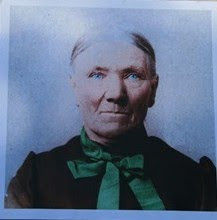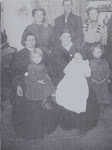 |
| Louisa Marshall Boyce |
 |
| Louisa Marshall Boyce/Boice Lovell, Wyoming |
Louesa Marshall Boice was born at Linton Hill Herforeshire England 12 March 1850. She was the fourth child of Thomas Marshall and Sarah Goode when she was six years of age she came to America with her widowed mother four sisters and a brother.
At that tender age she walked most of the way across the plains, as her mother was a member of the first handcart company to cross the plains. The last day of the journey a some horseman from Salt Lake met Grandmother with her little group treaking along pulling their handcart which contained all their earthly possessions, they took up the children on their horses and rode back to Salt Lake.
Louesa had a vivid recollection of a woman holding her on her lap and looking at her arms through the rays of the bright sun, the woman sobbed bitterly when she saw the skin hanging loosely oner the bone.
Her first home was in Ogden Utah. Her youthful days was spent in the fields gleaning the heads of grain after the harvesting was done. She truly earned her bread by the sweat of her brow.
 |
| "The Gleaners" |
Early in life she learned how to manipulate the spinning wheel and she gathered the wool from sage brush and wire fences where the sheep had been feeding, she gathered bones and carcasses, soaked ashes in water, and boiled the bones in the water which she poured off the aches and thus she made soap with which to wash the wool, clothing, etc.
After carding the wool she spun it into yarn and knit stockings for herself and other members of the family. In fact, she became expert in knitting. During the world war she won a souvenier for badge for knitting 50 pair sox and a certificate from President Wilson.
She was deprived of schooling having to work hard to help support the members of the family.
Her mother married William Chadwick but his presence in the family only heaped greater hardship on the children, as he compelled them to do manual labor with him in the fields during the summer and when winter came he would not allow the children to stay home, but turned them out to ind a home where elsewhere. When spring came he forced them to come back only to work hard all summer only to be turned away again when winter came.
Later the family moved to Franklin Idaho. [High Creek-] When Louisa was fourteen years of age she was driving a yoke of Oxen hitched to a wagon and was on her way to the grist mill with several sacks of wheat which was to be groung up into flour.
As the oxen approached a pole bridge, they beame stupid and Louesa had much difficulty trying to get them to cross ; in so doing, two of the wheels missed the bridge and she found herslef stranded in the ditch.
In the distance, not far away, three men had witnessed the scene and one of them came to her resuce. In a short time he had the wagon out of the ditch and Louesa was on her way rejoicing. She made her home with T. H. [Tryphena Hunt?]
Louesa said that he was the finest type of young manhood she had ever met little did she realize at that time hew as to be her companion for life.
The next spring Louisa was on her way to Montana where she expected to make her home with her sister Tryphena Hunt. Her first night was spent at Oxford Idaho. Before starting out the next morning, she found it necessary to do some repair work on her clothing. Being bashful and shy she hid herself in ath rear of the wagon and was busily engaged darning her stockings when a stranger stepped up and found her in this embarrassing position.
He went to one of his sons and told him that any young woman who could repair her clothing and darn stockings as this one could would make a good companion for a young man.
Martin Calvin took the hint. Louesa discontinued her journey to Montana Market Lake and they were married 7 May 1865, being the first couple to be married in Oxford. There were only two log houses in the settlement at that time. How happy they must have been as they worked together weaving willows into a shanty which served as their first home. A wagon box turned upside down was used as a bedstead upon which they slept. I have often wondered how they managed, living in a willow house when the rains descended.
Louisa was in her fifteenth year and weighed ninety pounds at the time of her marriage.

















No comments:
Post a Comment